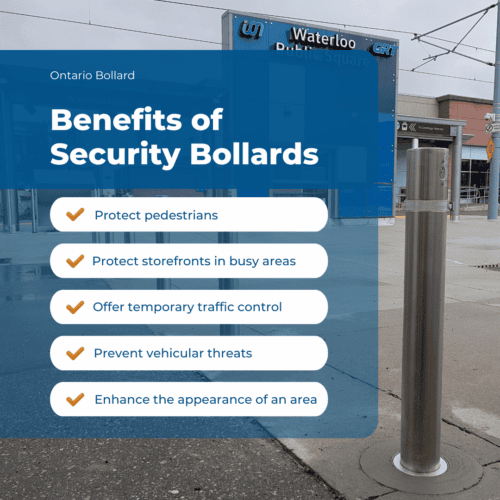
Bollard Installation Guide
Security bollards have become essential for protecting vehicles, workers, pedestrians, and buildings from potential hazards. Whether in Toronto, Brampton, Mississauga, Hamilton, Guelph, or other Ontario cities, selecting the right bollard depends on your specific needs and site requirements.
Types of Safety Bollards
Bollards are critical for protecting pedestrians and buildings. They come in various materials, typically metal or concrete and serve different purposes based on their type.
Removable Bollards
- Removable bollards provide both physical and visual barriers, ideal for temporary work zones. They signal lane closures, roadwork, or heavy traffic to drivers and pedestrians. Removable bollards are great for temporary restriction/access control.
Retractable Bollards
- Built into the ground, retractable bollards also known as collapsible bollards can be raised or lowered as needed. They are perfect for areas requiring frequent access such as government buildings or private property. These retractable bollards can be controlled automatically or manually.
Fixed Bollards
- Permanently installed, fixed bollards are used to protect areas from traffic. They are commonly found in shopping plazas and in front of government buildings and storefronts providing a robust security solution.
Choosing the Right Bollard
When selecting a bollard, consider the specific needs of your site. Each type offers unique benefits for different scenarios, ensuring safety and functionality. For professional advice and installation, contact Ontario Bollards today.

Why You Should Install Safety Bollards
Safety bollards provide numerous community benefits, such as:
- Enhancing Area Appearance: Decorative bollards add a creative touch to driveways and commercial properties.
- Protecting Storefronts: Bollards reduce theft risk and prevent vehicles from accidentally or intentionally driving into storefronts.
- Safeguarding Pedestrians: Bollards keep vehicles away from pedestrian areas, like bike lanes, park entrances, schools, and airports.
- Ensuring Driver Safety: Approximately 100 vehicles drive into buildings daily; bollards prevent such incidents, protecting those inside.
- Improving Night Visibility: Bollards with lighting devices enhance visibility and discourage crime.
- Providing Temporary Traffic Control: Removable & Surface mount bollards manage traffic during events or specific times, like school pick-ups and drop-offs.
- Restricting Access: Security teams use bollards to secure high-security areas.
- Preserving Historic Sites: Bollards protect against damage and vandalism at historic locations.
Selecting Your Bollards for Installation
When choosing bollards for installation in Ontario cities like Toronto, Brampton, Mississauga, Hamilton, and Guelph, it’s essential to consider the specific needs of each location. Ontario Bollards offers a variety of options tailored to diverse requirements.
Security and Crash-Rated Bollards
These bollards offer a wide range of use cases for industrial areas and high-security locations while providing traffic control. Made of durable materials, they can be customized in various colors and styles to suit your needs.
Retractable Bollards
Perfect for designating access for authorized maintenance, deliveries, or emergency vehicles, retractable or collapsible bollards block pedestrian and vehicle traffic when needed. They come in various shapes and sizes and are designed to minimize vehicle damage if struck.
Architectural and Decorative Bollards
Enhancing both aesthetics and security, architectural and decorative bollards are popular in front of buildings, near entrances, or along pathways. These bollards can include decorative chains and come in a wide variety of types and covers to match the style of historic or modern properties.
Expert Consultation and Installation
Ontario Bollards provides professional consultation to help you select the best bollards for your needs, ensuring compliance with local regulations and optimal safety for your site. Our experienced team handles everything from selection to installation, offering tailored solutions for each unique environment.
For more information or to schedule a consultation, contact Ontario Bollards today and secure your site with the best bollard solutions.
Bollard Installation Specifications
Key Factors to Consider Before Installation
- Legal Requirements:
- Local Codes: Ensure compliance with local building codes and ordinances.
- Permits and Depth: Consult with the Building Code Department regarding necessary permits and recommended digging depth.
- Emergency Access: Ensure passages allow emergency vehicle access by law.
- Consult Authorities: Work with site planners and local authorities to understand bylaws and ordinances.
- Site Plans:
- Architect’s Role: Refer to site plans created by the architect for spacing and installation methods.
- Spacing of Bollards:
- Row Installation: Install bollards in a row for visibility.
- ADA Compliance: Ensure enough space between bollards for wheelchair and motorized chair access.
- Contextual Spacing: Adjust spacing based on the area being protected and the expected traffic (pedestrians, cyclists, or vehicles).
- Additional Considerations:
- Purpose and Placement: Determine the primary purpose (e.g., protection, traffic control) and ideal placement based on site-specific needs.
- Material and Design: Choose bollards that fit the aesthetic and functional requirements of the location.
Preparing for Bollard Installation in Ontario
Preparing for Installation
Before installing bollards, it’s crucial to properly prepare the site to ensure the bollards stand straight and function correctly.
Check for Hazards: Before digging, check for underground hazards such as pipes, gas lines, and wiring. Refer to site plans or contact a professional to identify these hazards.
Drill the Holes for Bollard Bolts: Center the drill bit on the marked location and use a smaller drill to mark the centers. Drill to the full depth of the drill bit to create the necessary holes.
Clean the Site: After drilling holes and mixing cement, clean the worksite to remove any dirt and debris that could obstruct the placement of the bollards. Use a broom, pressure washer, or vacuum to ensure the concrete surface is clear and ready for installation.
Make a Concrete Base: If the bollards are being installed on a surface other than concrete, you need to create a stable concrete base. Concrete is resistant to weather changes and provides a stable platform for bollards. To create the base, cut the tubing to the correct length, leaving space for landscaping if necessary. Mix the concrete according to the manufacturer’s instructions until it has a moldable clay-like texture. Pour the concrete evenly into the hole, place the anchor casting inside, and allow it to cure for 2-3 days before proceeding.
How to Install Different Types of Bollards
Removable Bollards: Removable bollards are ideal for temporary work zones. Handle them carefully to prevent surface damage, and keep them in packaging until ready to install. Use a high-powered auger to drill holes and clean any debris with a vacuum. Place a rebel cage and gravel at the site, lay the bollard’s ground sleeve in the ground, and fill the hole while keeping the sleeve steady.
Collapsible Bollards: Collapsible bollards prevent vehicle damage and are flexible for temporary work zones. Set the depth control on your hammer drill according to the manufacturer’s specifications, drill holes, and clear debris. Insert a drop-in insert into each hole and secure it with a setting tool and hammer. Place the fold-down base over the holes, secure with washers and bolts, and test the bollard by raising and lowering it.
Fixed Bollards: Fixed bollards are easier to install than removable ones. Refer to site plans to determine installation locations and scan for underground hazards. Break the surface and dig a hole according to the bollard’s specifications. Insert the bollard base into a concrete mix, hold it in place to ensure it stands straight, and fill the hole with concrete. Clean any residue with a soft cloth and water.
Completing the Process
To prevent dust, debris, and water from accumulating on a flat-topped pipe bollard, finish it with a concrete top, bollard cap, or cover. A concrete top can be molded into a dome shape for durability. A bollard cap should be added while the concrete is wet to provide a uniform appearance. Alternatively, you can paint the bollard or add a plastic cover for reduced maintenance and enhanced appearance.
For professional bollard installation services in Toronto, Brampton, Mississauga, Hamilton, Guelph, and other Ontario cities, contact Ontario Bollards today.


Comments are closed